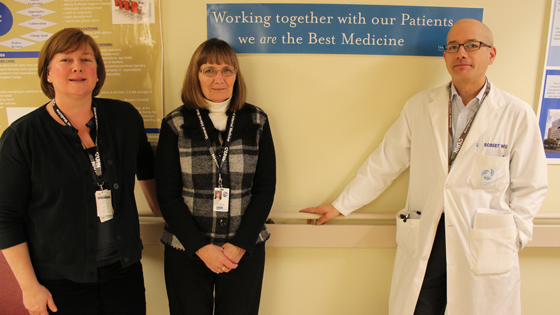
TGH’s General Internal Medicine Nurse Managers Beth Curiale and Joanne Ryan and Dr. Robert Wu continue to push boundaries in hospital communications. (Photo: UHN News)
Papers and pagers are still very much a reality in hospital clinic. But one team is trying to change that.
Working as a general internist at Toronto General Hospital (TGH), Dr. Robert Wu has seen the pitfalls of outdated communications technology firsthand. In a study he conducted to quantify his observations, Dr. Wu found that as many as one third of pages go unanswered.
"If you talk to nurses they'll tell you that it can be really tough to get in touch with anyone using a pager," he explains.
This can result in information falling through the cracks between the care team, which can in turn lengthen the amount of time it takes to care for a patient. These are avoidable scenarios, Dr. Wu says.
A step forward
To prevent miscommunication and shortages of communication, Dr. Wu and his colleagues have designed a new web-based tool – Clinical Message. It's making communications faster, handovers easier and increasing the accessibility of urgent messages for busy nurses and physicians in clinics.
"It uses some of these more advanced communications tools such as smartphones and web applications to move our communications system into the 21st century," Dr. Wu explains.
New-age communications
An urgent message on the system from a clinician may read, "NG Tube is in place. Can you please enter portable chest x-ray ASAP?" That message is answered by a colleague within two minutes with a quick, "Will do."
The hope, according to Dr. Wu, is that these quick communications will improve care.
The new tool is equipped with this secure messaging system, allowing nurses and physicians to send urgent and non-urgent messages to one another. Urgent messages are marked as such and sent as text messages to the team smartphone, which is kept by the person on call. Non-urgent messages are posted to the system, where they can be accessed when convenient.
Unlike text messaging or emails, the information is visible to the entire team responsible for a patient's care.
Within the web-based application, physicians and nurses also have access to a handover tool. This element contains a list of patients along with each patient's demographics, diagnosis, medical history, active issues and discharge plans. That makes handovers more seamless as all clinicians involved in the circle of care are able to update and review messages.

Autumn Taylor, Patient Care Coordinator, uses the new web-based tool to quickly get in touch with colleagues in Internal Medicine.
(Photo: UHN News)
Real-life results
From May 2011 to August 2012, Dr. Wu and his team analyzed the usage and efficacy of the new tool on general internal wards at TGH and Toronto Western Hospital. Over that period, nearly 70,000 messages were sent – on average 15 daily per team, or one per patient.
"Overall, we've improved for both the nurses and physicians on how we communicate," says Dr. Wu.
Users – doctors and nurses – found the tool increased efficiency, accountability, timeliness and collaboration. According to the study recently published in the
Journal of Hospital Medicine online, about 80 per cent of nurses and physicians agreed Clinical Message helped speed up their daily work tasks.
The perceptions are positive, says Dr. Wu, but there is always room to improve.
Both physicians and nurses had difficulty communicating complex medical issues using the system.
"We are undergoing further enhancements to make it better," Dr. Wu says. "It's about improving communication and patient care even further."
Dr. Wu is quick to note that the Clinical Message system is the effort of a large team, including Sherman Quan, Jason Uppal, Dante Morra, Eva Appel, Beth Curiale, Joanne Ryan, Teri Arany, and the nurses, physicians and health professionals on UHN's General Internal Medicine team.
Continuing to advance
Once enhancements are in place, Dr. Wu will study the effects of the tool on patient care.
"Our next step is to see if it actually does improve care, reduce adverse events, and improve time to rescue patients that are critically ill," he says.
After that?
Dr. Wu says he sees a mobile app in the future, along with a broader reach for these new communications tools.
"We would like to eventually extend it so that we're able to coordinate patient care not just while patients are here, but also beyond our hospital walls," he says. "Communication is key to collaborative care for patients with chronic diseases."
